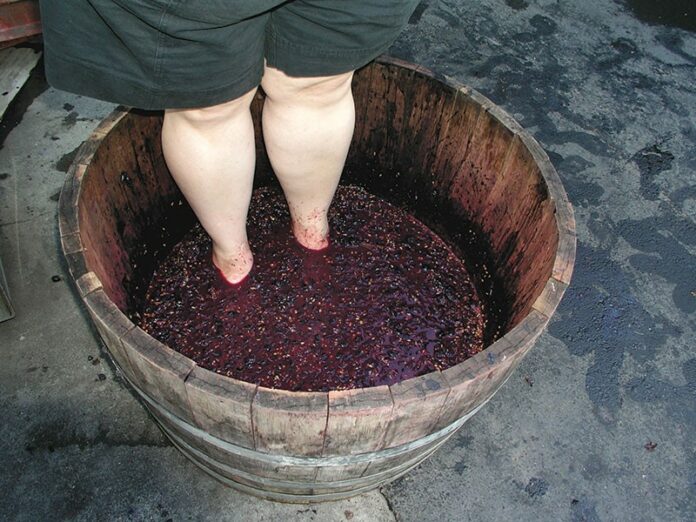The grape is nature’s original smack pack. Inside each sturdy package is all the sugar required to make wine, and outside is the yeast needed to ferment that sugar. All you’ve got to do is break the grape.
Over the centuries, the ancient method of simply treading grapes underfoot has been replaced by technology of ever-increasing sophistication, from hand-cranked crushers to computerized sorting machines. Yet in some of the savviest new wineries, from New Zealand to Napa Valley, foot-stomping has come back into vogue.
“I don’t know enough people that do it to say that it’s in vogue,” demurs Scott Schultz, assistant winemaker at Wind Gap Wines. “But we foot-stomp everything here.” By everything, besides a few bins of Cabernet Sauvignon and Pinot Noir they destemmed mechanically this crush, Schultz is talking about a lot of grapes—at least 250 tons, each ton coming in two half-ton bins.
“We have great interns this year,” says Schultz. “They see those bins come in—they run over, pop their shoes off, put their shorts on, and they’re after it.” Located in the Barlow in Sebastopol, Wind Gap’s crush pad is just around the corner from its popular tasting room. People walk by all the time and exclaim, “I didn’t know people still did that!”
“It began as the only logical way to do it, because we didn’t have a crusher,” Wind Gap founder Pax Mahle explains. “Now that’s just how we do it.” Since the grapes are often picked in the middle of the night and come in well chilled, it’s not all glamor and fun. Still, most of the time, the team goes without the boots provided for the task.
And when they step on it barefoot, says Schultz, “we know what that fruit feels like pretty intimately.” Their feet relay information that may be helpful to winemaking, like temperature and condition of the grapes and stems. “It tells you a lot without really doing anything—you’re just relying on your senses.”
Winemaker Duncan Meyers, cofounder of Healdsburg’s Arnot-Roberts, gets more technical: “The stems also bring aromatic lift to the wine and help to slow down the fermentation kinetics by providing a more permeable mass for the juice to channel through, resulting in cooler peak temperatures and a gentler fermentation curve.” Other benefits include color stabilization and other features that expensive enological products offer, to similar effect. “Many of our favorite producers in the Rhône Valley, Burgundy and the Jura in France use this ancient technique to good result,” says Meyers.
There’s still time to try your hand—or foot, rather—at stomping grapes at the Sonoma County Harvest Fair, Friday, Sept. 30, through Sunday, Oct. 2, at 1350 Bennett Valley Road, Santa Rosa.











